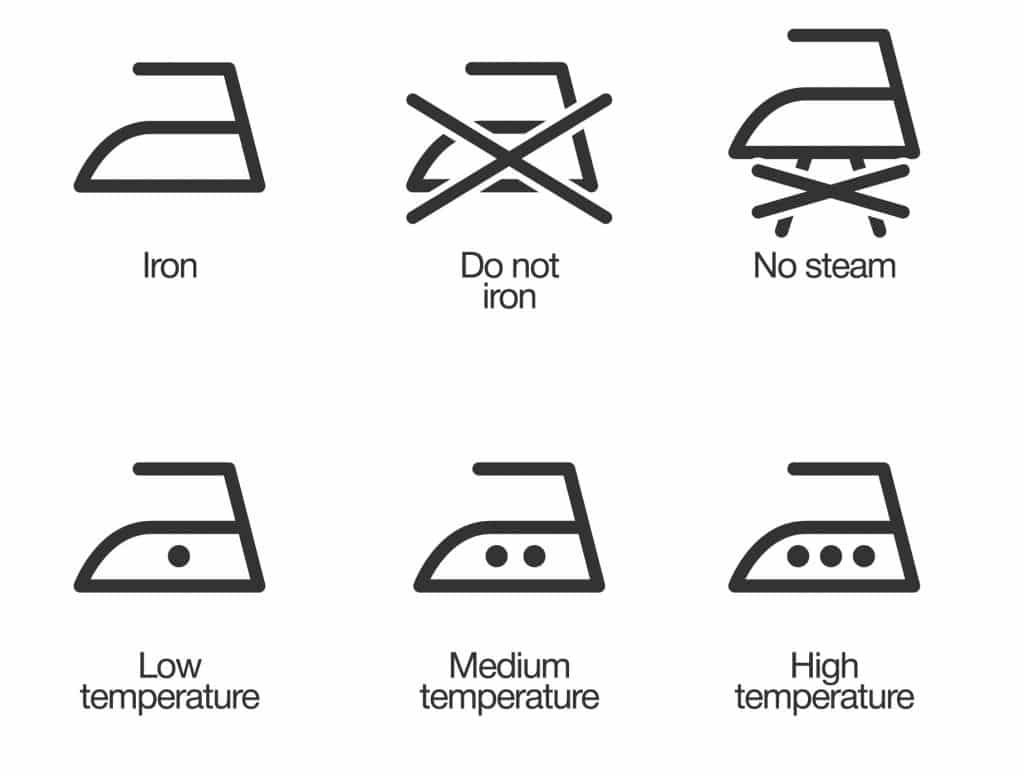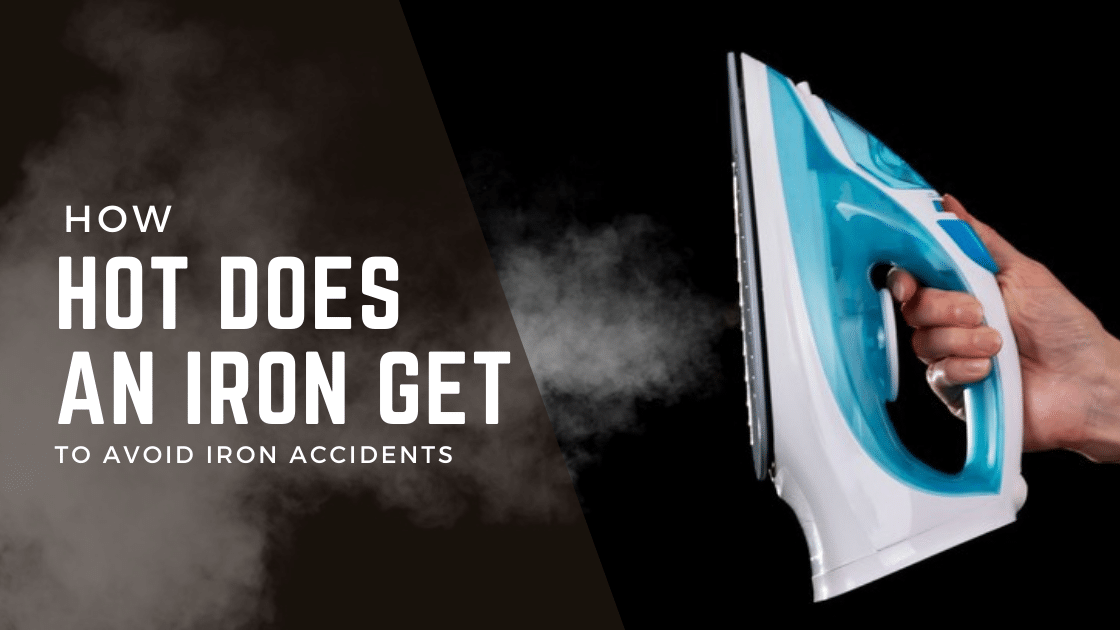Published by Hala Zaqqout on March 1, 2022 | Last updated on May 15, 2023
If you use an iron, you may have some questions, such as “how hot does it get?” Don’t panic! Cleaners Advisor is here to give you the answer.
Your iron offers a number of heat settings that you may use on a variety of commonly available fabrics, posing a new problem: determining which temperatures are best for certain fabrics.
One thing to keep in mind is that you don’t want your iron to get too hot, as you don’t want to burn your clothes’ fabric. Believe us, people have done it before!
Let’s get started and discuss your iron and how hot does an iron get.
- How Hot Does an Iron Get?
- What are Iron Symbols?
- What is the Maximum Temperature an Iron Can Reach?
- Fabrics and Specific Temperature Settings
- Some Tips for Ironing
- How Hot Does an Iron Get FAQ
- To Wrap Up
- How Hot Does an Iron Get?
- What are Iron Symbols?
- What is the Maximum Temperature an Iron Can Reach?
- Fabrics and Specific Temperature Settings
- Tips for Ironing
How Hot Does an Iron Get?
It’s important to know how hot does an iron get to preserve your clothes. If your iron has a different scale or if you want to know more exact temperatures for ironing different types of fabric, look at the care tag to know what you need to do to take care of your clothes.
Depending on the fabric, heating is usually done at a temperature of 180–220 °Celsius (356-428 Fahrenheit).
This video below shows thermal imaging of an Iron heating up.
What are Iron Symbols?

Iron symbols can be found on clothing labels and laundry symbols, and they’re a great guide to know what temperature to iron at. You don’t want to ruin a garment by ironing it without checking for this important symbol.
Here are the ironing symbols used on labels:
1. No Dots
Use an iron. This means you can use steam and iron the item at any temperature. This symbol is often seen on cotton fabrics.
2. One Dot
Use a cool iron with a sole plate temperature of no more than 1100C. (230F). It may not be advisable to steam-iron this fabric.
3. Two Dots
Use a warm iron with a sole plate temperature of no more than 1500°C (300F).
4. Three Dots
Use a hot iron with a sole plate temperature of no more than 2000°C (390F).
5. Crossed Out Iron
Ironing or steam ironing is not recommended. This is for fabrics that will be damaged or melted if ironed.
6. Crossed Out Lines Underneath the Iron
Steam should not be used since it may leave marks on the fabric.
What is the Maximum Temperature an Iron Can Reach?
Likewise, people ask, what is the maximum temperature an iron can reach? Irons may reach a maximum temperature of 500 degrees on average (F). That’s right, it’s that hot!
One of the things you’ll want to look at is the wattage. A higher wattage indicates that the iron can get extremely hot. Not to mention that it will consume more power.
As a rule of thumb, more wattage means more power. At the same time, a higher wattage iron will heat up much faster than others.
Fabrics and Specific Temperature Settings
You need to know how hot does an iron get for each fabric type. Some fabrics will be suitable till a certain temperature is reached. Pay close attention to this part so you can know what temperature to set it to. Let’s take a look at the following fabrics and temperatures needed:
1. Linens
Linen can endure a good amount of strong heat. It will work best if the iron temperature is around 445 degrees (F) or if the setting on your iron is 5.
At first, ironing out the wrinkles may be difficult. But you’ll get the hang of it over time. The material should be dampened or pre-moistened. If you’re dealing with stubborn wrinkles, don’t forget to use steam.
2. Cotton
Dry ironing can be used with this fabric. Ironing with steam is also suitable.
Set it to 400 degrees Fahrenheit (F) or setting 5.
3. Wools
Keep in mind that wool is fragile. As a result, you should place a pressing cloth between the iron and the fabric. This will save the wool from being burned.
Check to see if the clothes you’re ironing is inside out. To make it easier, dampen the fabric. The heat should be set to 3 or 300 degrees (F).
4. Polyester
Can you iron polyester? It’s easy to iron polyester. This fabric does well when using low or medium heat.
Choose iron setting for polyester to 3- or 300-degrees Fahrenheit while ironing it (F). Make sure it’s humid or pre-moistened before using it.
Some Tips for Ironing
Here are some ironing tips for various fabrics:
1. Cotton
You can iron thicker cotton fabrics when they are still slightly damp.
2. Beaded Items
Place a thick towel on the ironing board, as well as a pressing cloth. Place the fabric beads on the towel face down, then cover with the pressing cloth. Iron on a low setting, being cautious not to over press the fabric.
3. Lace
Always use a pressing cloth because the tip of the iron can snag the delicate lace or get caught in one of the holes.
4. Linen
Like cotton, linen can be ironed while the fabric is still damp. Linen will need a very hot iron to get wrinkles out. Hang your item up immediately after ironing as linen is a wrinkle magnet.
5. Rayon
If the iron comes into direct contact with this semi-natural cloth, it will turn shiny. Iron the back of the garment with a pressing cloth.
6. Stain
Don’t forget to iron on the wrong side of the item and bring your pressing cloth. Water and steam may quickly stain satin, so keep everything dry.
7. Sequins
Sequins should not be ironed. They are frequently made of metal or plastic and dislike being exposed to heat. You could try steaming without touching the surface, but these items often have a dry clean only label, so check carefully.
8. Silk
Silk is a delicate material that should be handled with caution. Use a pressing cloth and press on the wrong side. Water or steam should not be used because they would leave marks.
9. Synthetics/ Polyester
Man-made fabrics have low melting points and extra care must be taken when ironing. To avoid melting the fabric, set the iron to a low setting and use a pressing cloth.
10. Velvet
Velvet is usually smooth on the back and has a nap on the outside. Turn the item over to the wrong side and steam it without pressing the iron’s plate to the fabric.
11. Wool
Keep in mind that heat might cause wool to shrink, so proceed carefully. Use a pressing cloth and a low-heat setting on the iron. It’s better to iron on the wrong side to avoid leaving any glossy marks.
How Hot Does an Iron Get FAQ
To Wrap Up
Nothing is more frustrating than ruining a beautiful piece of fabric or a brand new piece of clothes with a scorching iron set to the wrong temperature.
Knowing how hot does an iron get, your ironing symbols, and remembering to iron with care will help you prevent ironing mishaps and preserve your clothes.
Still have any question about how hot does an iron get and iron temperatures, then drop it in the comments box below and we’ll answer you as soon as possible.


![Over the Door Ironing Board [Best Tested Models in 2023]](https://cleanersadvisor.com/wp-content/uploads/2023/04/Blog-Banner-for-Website-Content-1-350x190.png)
![Tabletop Ironing Board: Best Models [Tested by Experts]](https://cleanersadvisor.com/wp-content/uploads/2023/04/Blog-Banner-for-Website-Content-60-350x190.png)
![How to Shrink a Bathing Suit [To Ensure Good Summer Looks]](https://cleanersadvisor.com/wp-content/uploads/2023/05/How-to-Shrink-a-Bathing-Suit-350x190.png)

![How to Iron a Shirt [2023 Complete Guide with Pictures]](https://cleanersadvisor.com/wp-content/uploads/2022/03/how-to-iron-a-shirt-350x190.png)
![Find Out How to Close an Ironing Board Properly [2023 Guide]](https://cleanersadvisor.com/wp-content/uploads/2022/01/Blog-Banner-for-Website-Content-350x190.png)